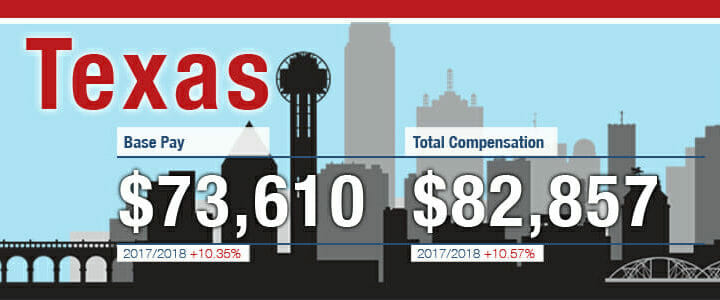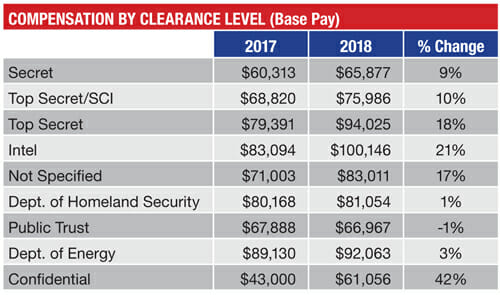Few states in our union take as much pride in themselves as the great state of Texas. And to be honest, they’ve got a lot to be proud of – like a unique history, killer food, and a great economy. There’s yet another reason to take pride in the Lone Star State: It’s a great place to be a cleared professional.
With the exception of California, the mean base salaries and mean total compensation in Texas increased more than any other state in the country in 2018. Mean base salaries jumped by 10% to $73,609, and total compensation increased by 11% to $82,856.
But the numbers can be tricky. Despite these increases, Texas still has the nation’s lowest mean base salary and average total compensation for the cleared workforce. However,the state also has a lower cost of a living. According to Zillow, the median home price is $184,112. It’s a pretty penny, to be sure, but it’s more than $100,000 less than the home prices in Virginia, Maryland, or Washington, D.C.
With more than 15 active military bases, as well as NASA’s Johnson Space Center, Texas also stands to benefit from growing spending on aerospace and defense. The Lone Star State is currently home to more than 170,000 active duty personnel, reservists, National Guard personnel, and DoD civilian workers.
In addition to the military presence, the ‘Silicon Hills’ are making a name for themselves for the growing cluster of tech companies choosing to make a home in the hills near Austin. For this reason, Texas has been singled out as one of the top five states for technology jobs, while Austin and Dallas have also been singled out as top cities for tech professionals.
Clearance Level and Salaries
While overall compensation in Texas remains lower than other top cleared states, things are on the upswing for cleared Texans. Mean base pay increased 10% and median base pay increased more than 12% in 2018.
Employees with a full-scope polygraph exam increased nearly 13% in mean base pay, while mean base pay of managers increased by 14% and their mean total compensation increased by 16%. The mean base pay of senior level career professionals increased by 12%, while their mean total compensation increased by 13%.
Texas, Military, and the Army Futures command
The Texas workforce is buoyed an enormous military presence, which includes Joint Base San Antonio, Sheppard Air Force Base, Fort Bliss, Fort Hood, and Joint Reserve Base Fort Worth.
This presence will increase as the Army Secretary Mark T. Esper announced in July that Austin will be the location for the headquarters of the new U.S. Army Futures Command. The Lone Star State’s capital city was chosen from a list of five other competing locations. In the criteria of selection that included proximity to science, technology, engineering, and math (STEM) workers and industries – as well as private-sector innovation – Austin ranked highest.
Austin’s quality of life, density of industry, and academic talent – as well as the cost of doing business -help enable it to attract both new startups, as well as established companies. This aspect also played a role in the decision.
“That ecosystem cannot be duplicated from behind the walls of traditional posts and forts,” said Army Undersecretary Ryan D. McCarthy, who led the selection process, adding that recognition of that concept is a radical change for the Army’s culture.
A six-member team will establish the initial operating capability at the Army Futures Command, and within a year the full operating capability will be achieved, with an HQ staff of 500. This will include 100 uniformed soldiers and 400 Army civilians. A four-star general will take command, but the officer’s name has not yet been made public.
The goal of the Army Futures Command is to shepherd development of the service’s six modernization priorities of improved long-range precision fires, a next-generation combat vehicle, future vertical lift platforms, a mobile and expeditionary Army network, air and missile defense capabilities, and soldier lethality.
Aerospace Taking Flight in Texas
Aerospace is a huge sector in Texas; the state accounts for 9.6% of the national aerospace and defense workforce, according to the Aerospace Industries Association. There were 230,410 total jobs in the aerospace and defense sector in 2017. This included 64,870 direct employees as well as 165,540 in supply chain employment.
In July, Lockheed Martin hired more than 1,800 new employees in support of the F-35 program, meeting a commitment made by company CEO and Chairman Marillyn Hewson back in January 2017. The company plans to create an additional 400 jobs at its Forth Worth facility to support increased production of that program.
“The F-35 is an iconic product that represents the best of U.S. innovation, technology leadership, and advanced manufacturing,” said Hewson, as reported by the trade magazine Aerospace Manufacturing and Design. “The program supports 194,000 direct and indirect jobs nationwide, and as we ramp up production we are creating even more opportunities for American workers. The men and women who participate in the F-35 program take pride in delivering unmatched, fifth-generation capabilities to the U.S. military and our allies around the world.”
Research and development for the aerospace industry is also big in Texas. According to the 2017 Texas Aerospace, Aviation, and Defense report from the Texas governor’s office, 17 of the world’s 20 largest aerospace companies have major operations in the state and Texas is home to about 9%of all aerospace manufacturing jobs.
In addition, from 2013-2015 Texas universities dedicated more than $93 Million to aerospace technology research, according to the Texas Higher Education Coordinating Board. The University of Texas at Austin and Texas A&M University together accounted for more than half of the total expenditures in this field. The goal is for Texas is to retain much of this talent in-state. In January, David Daniel, deputy chancellor for the University of Texas System, spoke at an aerospace conference and noted that there are currently about 1,000 undergraduates and 350 master’s or doctoral students studying aerospace. Many in Texas are hoping this will deepen the state’s talent pool.
Space Exploration
Texas has also played a long role in the history of human spaceflight. Since NASA’s Project Gemini in 1965, Houston’s Johnson Space Center (JSC) has served as the primary flight control center for all U.S. manned space missions, including the Apollo, Space Shuttle, and International Space Station programs. While NASA officially retired its space shuttle fleet in 2011, JSC still directly employs about 3,000 workers in Houston, 65% of whom are engineers and scientists, while around 50 contractor firms employ an additional 7,400 workers at the space center. In 2014, JSC managed an annual budget of $4.4 Billion, with nearly $3 Billion of that expended on contracts with Texas-based businesses.
Since the end of the shuttle program, NASA has ramped up programs to support the U.S. commercial space transportation industry. The Commercial Crew and Cargo Program Office (C3PO), which is now based at JSC, invests in the development of private transportation systems capable of ferrying both cargo and human crews to the International Space Station. Its partners include SpaceX and Blue Origin among others.
This article is one in a series based on the 2018 ClearanceJobs Compensation Survey. This survey was administered online between October 30, 2017 and February 9, 2018. Participants had to have a current, active federal security clearance and be currently employed to be included in the results, which included 20,883 usable responses.






